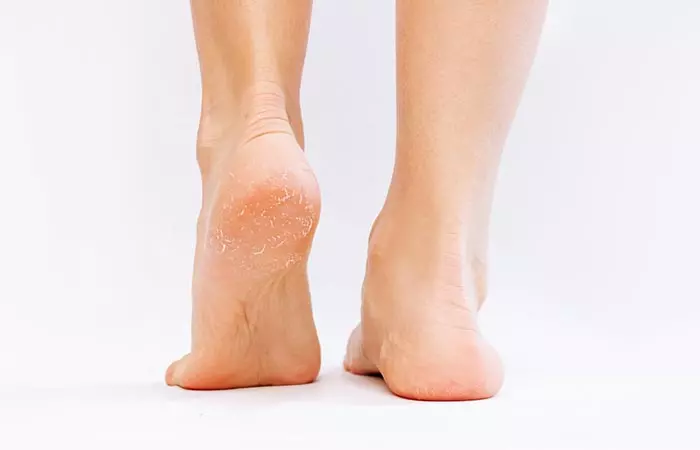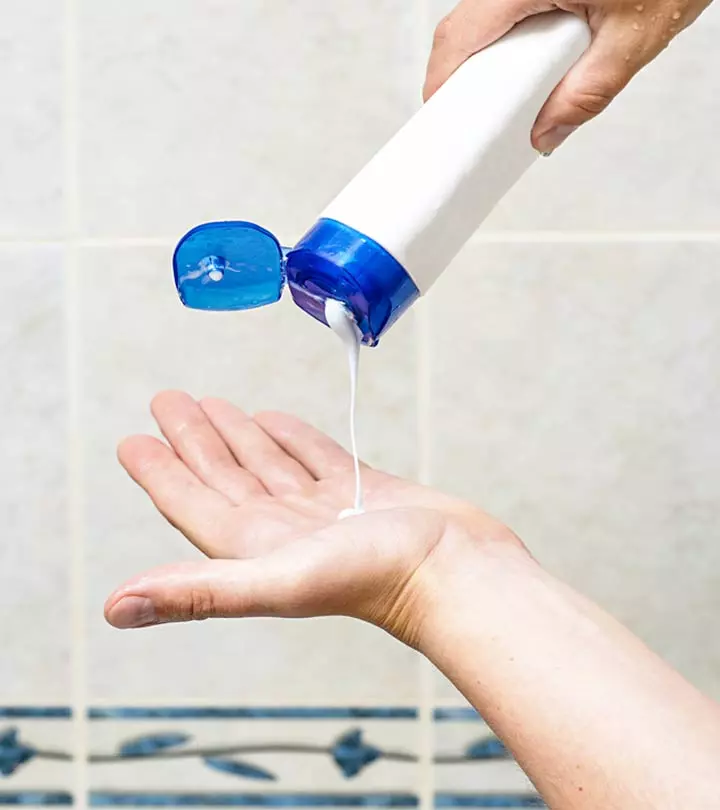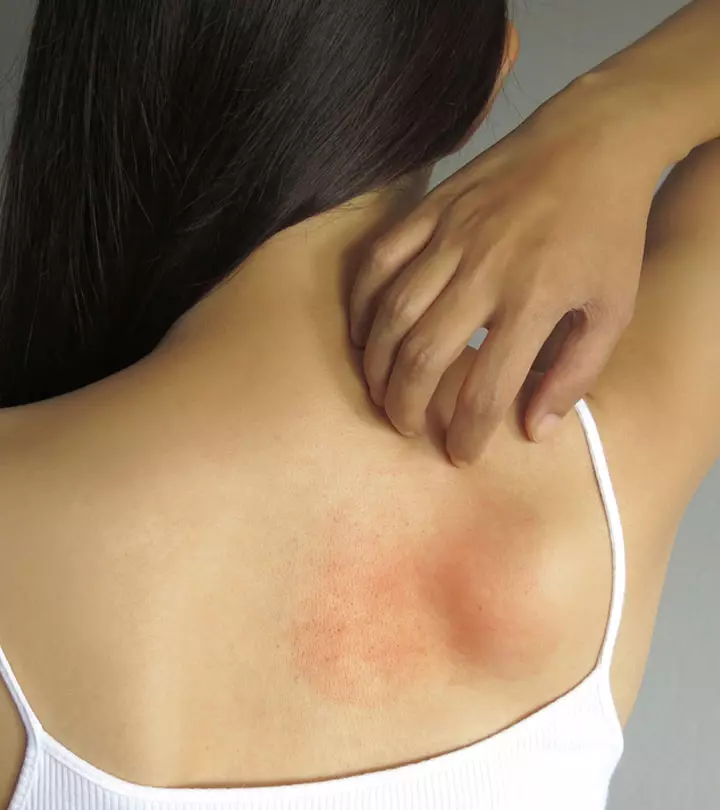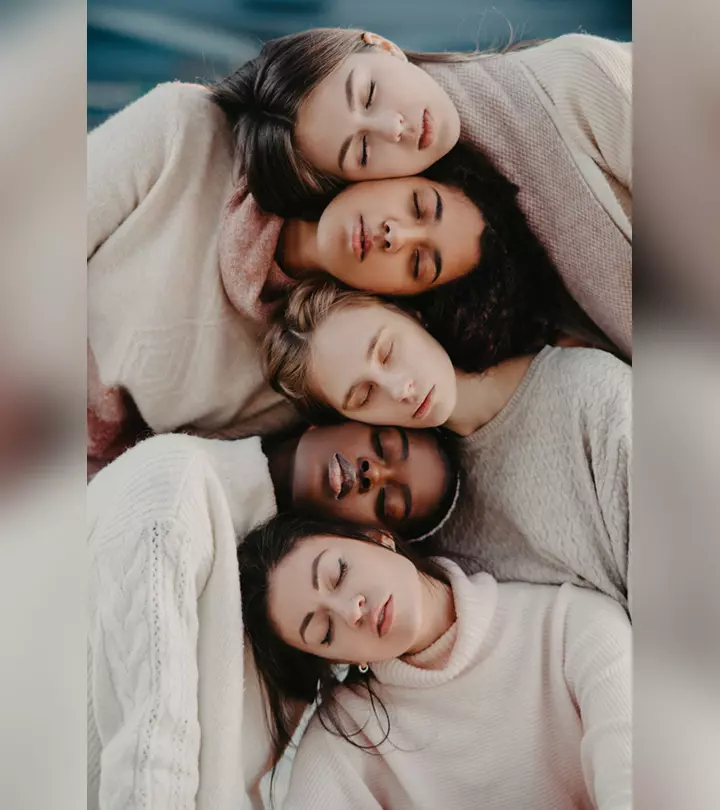Can You Use Selsun Blue For Skin Issues?
Quite surprisingly, an anti-dandruff shampoo can do quite a lot for the skin.

Image: Shutterstock
Selsun Blue is a common trade name for selenium sulfide. It is used commonly in anti-dandruff shampoos as it helps reduce scalp greasiness and itchiness and slows down the growth of dandruff-causing skin cells on the scalp. Besides, anecdotal evidence suggests that using Selsun Blue for skin may help treat several skin conditions apart from an itchy scalp.
But what does science say? Is Selsun Blue safe to use on the skin? Or does it cause more harm? In this article, we discuss the benefits of Selsun Blue for skin and its potential risks. Keep reading.
In This Article
Benefits Of Selsun Blue For Skin
The Selsun shampoo contains selenium sulfide, a substance that effectively treats a number of scalp disorders like dandruff and psoriasis by reducing inflammation and inhibiting the proliferation of skin cells. Keep reading to know more Selsun shampoo uses and benefits that you should know about.
1. May Help Treat Thickening Of Skin

A study published in 2018 suggests that topical application of a selenium sulfide lotion or shampoo may treat hyperkeratosis (thickening of skin’s outer layer), especially involving palms and soles (1). As part of the study, three individuals with hyperkeratosis were successfully treated with selenium sulfide in either a 2.5% lotion/shampoo or a 2.75% foam without any adverse effects. Besides, the response was not only rapid but also complete and sustained.
 Trivia
Trivia2. May Help Treat Seborrheic Dermatitis

This skin condition is characterized by red patches with yellow-gray scales that mostly appear on the face, scalp, upper chest, and back. A study found that selenium sulfide used in concentrations of 0.5% to 2.5% in lotion, ointment, cream, and jelly vehicles may help treat the skin condition effectively. Besides, concentrations of 0.5% and 1% were found to be less irritating than and as effective as the higher concentrations (2).
This disease may often occur in conjunction with other skin conditions like acne vulgarisi A skin condition caused by inflammation and obstruction of the hair follicles by oil and dead skin cells. and eczema (3). Hence, treating seborrheic dermatitis may help reduce the flare-up of these conditions, as it works as an anti-infective agent.
3. May Help Treat Pityriasis Versicolor

Pityriasis (tinea) versicolor is a skin condition that causes hyperpigmented and hypopigmented scaly patches. It is caused by the fungus Malassezia furfur. A 2004 published research suggests that selenium sulfide may treat this skin condition effectively with its antifungal properties, besides showing better efficacy than sodium sulfacetamidei A medication with antibiotic properties that is applied topically to treat pimples and seborrheic dermatitis. (4). However, it may cause certain adverse effects. Hence, practice caution.
4. May Help Treat Rashes

Selenium sulfide is an antifungal agent. Anecdotal reports suggest that it may be used to treat skin rashes. Selsun Blue contains selenium sulfide, an antifungal agent effective against fungal skin conditions (5). This makes it beneficial for treating issues like tinea versicolor and seborrheic dermatitis. The antifungal properties may help reduce the growth of Malassezia furfur, the fungus responsible for these skin conditions. Another study published in 1995 compared the effectiveness of a 1% selenium sulfide shampoo in treating tinea capitis (a fungal scalp infection causing rashes) in children. The result showed that the 1% shampoo worked well in killing the fungal spores and clearing the infection (6).
These are the potential skin benefits of Selsun Blue. But how do you use it for achieving the desired results?
Key Takeaways
- Selsun Blue (or selenium sulfide) is a common ingredient in anti-dandruff shampoos that also reduces scalp greasiness.
- It works as an antifungal agent and reduces the risk of infections, such as tinea versicolor, flaky scalp, and seborrheic dermatitis.
- Selsun Blue should only be applied to the skin and left on for the prescribed time duration.
How To Use Selsun Blue For Skin

Here are a few practical tips to know before using Selsun Blue for skin issues:
- Selsun Blue is meant for use on the skin only.
- Ensure you shake the package before use (as directed on the package).
- Remove jewelry before using the product.
- Rinse your hair and scalp before applying the product to treat seborrheic dermatitis or scalp dandruff.
- Massage the product in and leave it on for the prescribed duration.
- Check the label to understand if the product can be used on color-safe and processed hair.
- Keep in mind that each skin or hair care product may have slightly different application instructions, so be sure to look out for those.
- For tinea versicolor, apply selenium sulfide to the affected area. Add a few drops of water to form a lather. Leave it on the skin for about 10 minutes and wash off. This method may help you get rid of tinea versicolor effectively.
- After using selenium sulfide, it’s crucial to wash your hands. This simple step ensures your safety and hygiene. Remember not to leave this medication on your hair, scalp, or skin for a longer period, and do not use it more often than directed.
- Consult a doctor or pharmacist if your condition worsens or does not improve despite using Selsun Blue.
Note:
Do not apply any products containing Selsun Blue into your eyes, nose, or mouth. Avoid applying it to broken or inflamed skin, unless directed by a medical professional, as it may cause swelling and irritation.
 Quick Tip
Quick TipSelenium compounds are not easily absorbed through the skin. Hence, using medicated shampoos containing selenium is generally considered safe. However, one may still experience side effects like ontact contact dermatitisi An itchy rash on the skin caused by contact with a specific substance or allergen, making the skin red and inflamed. (7). Read to know the other side effects of Selsun Blue in the following section.
Selsun Blue: Side Effects And Precautions
The side effects of Selsun Blue include (8):
- Redness, burning, itching, stinging, and irritation of the skin
- Scalp sores, increased skin oiliness, and nail hyperpigmentation
- Scalp hyperpigmentation
- Scalp discoloration
- Alopecia (hair loss)
- Allergic reactions
- Rarely, nausea may occur due to the medication’s odor
Note:
Children aged below five years and women who are pregnant or breastfeeding should not use Selsun shampoo.
Do not use Selsun shampoo if:
- You are allergic to selenium sulfide or any of the other ingredients of the medicated shampoo.
- You have broken or severely inflamed skin
Some individuals may experience severe allergic reactions, including difficulty breathing and swelling of the face, lips, or throat. Seek immediate medical attention if these symptoms occur.
Kevin Bradshaw, a fitness vlogger, shares that he has been using Selsun blue shampoo on his skin for 13-14 years. He uses it for five minutes, as recommended by his doctor. However, he suddenly experienced a reaction after using the product. He says, “Two weeks ago, I was putting up Selsun blue on both sides of my neck for three to five minutes like recommended, guys. It literally burnt my skin, guys. I have marks all down my neck on both sides (i).” Kevin states that if you experience something like this, avoid using the shampoo daily. He advises using it only 3 days a week and only for a minute. Therefore, it’s important to do a patch test before using it as directed for your condition to ensure that you do not have any sensitivities to the product.
Do you know that the food we take contains selenium? But does it make the food healthy or harmful? Keep scrolling to know the answers.
Is It Wrong To Eat Food With Selenium?
No. Selenium is an essential nutrient for humans and animals. People receive a majority of their daily selenium intake from food, and to a lesser extent, from water. However, selenium can be harmful when regularly taken in amounts higher than those needed (8).
The seriousness of the adverse effects depends on how much selenium is taken and how often. Brittle hair and deformed nails can develop even if mildly excessive amounts of selenium are taken over long periods.
Anecdotal evidence suggests that people may also lose feeling and control in their arms and legs in extreme cases. Swallowing a large amount of selenium supplement pills could be life-threatening without immediate treatment.
Infographic: Top Benefits Of Selsun Blue For Skin
Selsun Blue is an anti-dandruff ingredient added to shampoos to improve scalp health and treat fungal skin infections. It reduces flaking, irritation, and redness on the scalp. Recently many people have started using this shampoo on their skin. Surprisingly, it can actually boost skin health!
Check out the infographic below to learn how it can be used to treat various skin issues. Illustration: StyleCraze Design Team
In A Nutshell
Selsun Blue or selenium sulfide is a common ingredient in anti-dandruff shampoos. Using Selsun Blue for the skin is effective as it offers antifungal properties that help protect the skin from infections and treat several skin issues and scalp problems. The benefits of Selsun Blue include treating skin conditions like tinea versicolor, dermatitis, rashes, and hyperkeratosis. You can use this ingredient on your skin and hair, but remove your jewelry before using it. Also, do not keep the skin in contact with this ingredient for more than the prescribed duration. It may also cause side effects like discoloration, blistering, and rashes. Finally, always use the product as per the instructions given outside the package or by a doctor.
Frequently Asked Questions
Can Selsun Blue be used for all skin types?
Due to its active ingredients, Selsun Blue is primarily designed for treating dandruff and may not be suitable for all skin types, particularly sensitive or dry skin. To ensure safe usage, it’s important to conduct a patch test before applying it to your entire skin.
Can you sleep with Selsun Blue on?
No. Leaving Selsun Blue on your skin for too long may result in an allergic reaction (8). Ensure you follow the instructions for safe results.
Can we use Selsun Blue for skin psoriasis?
Yes. Scientific evidence suggests that topical selenium sulfide may effectively improve psoriatic plaques (1).
Does Selsun Blue get rid of white spots on skin?
Yes. Selsun Blue has antifungal properties that may treat the white spots (hypopigmentation) on the skin (8). Consult your doctor for proper instructions and dosage.
Can we use selenium sulfide for burnt skin?
There is currently no research to support the use of Selsun Blue on burnt skin. Consult a doctor for more information.
How long should you leave Selsun Blue on sunspots?
Leave Selsun Blue on the affected areas for 10 to 15 minutes before washing it off with water.
Illustration: Selsun Blue For Skin: How To Use Benefits And Side Effects

Image: Stable Diffusion/StyleCraze Design Team
Learn how to use anti-dandruff shampoo safely and effectively to clear up acne. Check out this video to get more information.
Personal Experience: Source
StyleCraze's articles are interwoven with authentic personal narratives that provide depth and resonance to our content. Below are the sources of the personal accounts referenced in this article.
i. How I burned my skin with Selsun bluehttps://www.youtube.com/watch?v=-WZmFA_gL_8
References
Articles on StyleCraze are backed by verified information from peer-reviewed and academic research papers, reputed organizations, research institutions, and medical associations to ensure accuracy and relevance. Read our editorial policy to learn more.
- Topical Selenium Sulfide for the Treatment of Hyperkeratosis
https://www.researchgate.net/publication/327564660_Topical_Selenium_Sulfide_for_the_Treatment_of_Hyperkeratosis - Observations on the Use of Selenium Sulfide and Hydrocortisone Ointment
https://jamanetwork.com/journals/jamadermatology/article-abstract/524873 - Seborrheic Dermatitis and Malassezia species
https://www.ncbi.nlm.nih.gov/labs/pmc/articles/PMC2923939/ - A Double-Blind Comparative Study of Sodium Sulfacetamide Lotion 10% Versus Selenium Sulfide Lotion 2.5% in the Treatment of Pityriasis (Tinea) Versicolor
https://cdn.mdedge.com/files/s3fs-public/Document/September-2017/073060425.pdf - Antimicrobial and antiviral activity of selenium sulphide nanoparticles synthesised in extracts from spices in natural deep eutectic solvents (NDES).
https://www.ncbi.nlm.nih.gov/pmc/articles/PMC8996440/ - Comparison of 1% and 2.5% selenium sulfide in the treatment of tinea capitis
https://pubmed.ncbi.nlm.nih.gov/7795774/ - CONTACT DERMATITIS FROM SELENIUM SULFIDE SHAMPOO
https://jamanetwork.com/journals/jamadermatology/article-abstract/524452 - Selenium
https://www.ncbi.nlm.nih.gov/books/NBK557551/ - Tinea Versicolor – An Epidemiology
https://www.researchgate.net/publication/45459485_Tinea_Versicolor_-_An_Epidemiology
Read full bio of Dr. Schwarzburg
Read full bio of Anjali Sayee
Read full bio of Ramona Sinha
Read full bio of Swathi E


























Community Experiences
Join the conversation and become a part of our empowering community! Share your stories, experiences, and insights to connect with other beauty, lifestyle, and health enthusiasts.